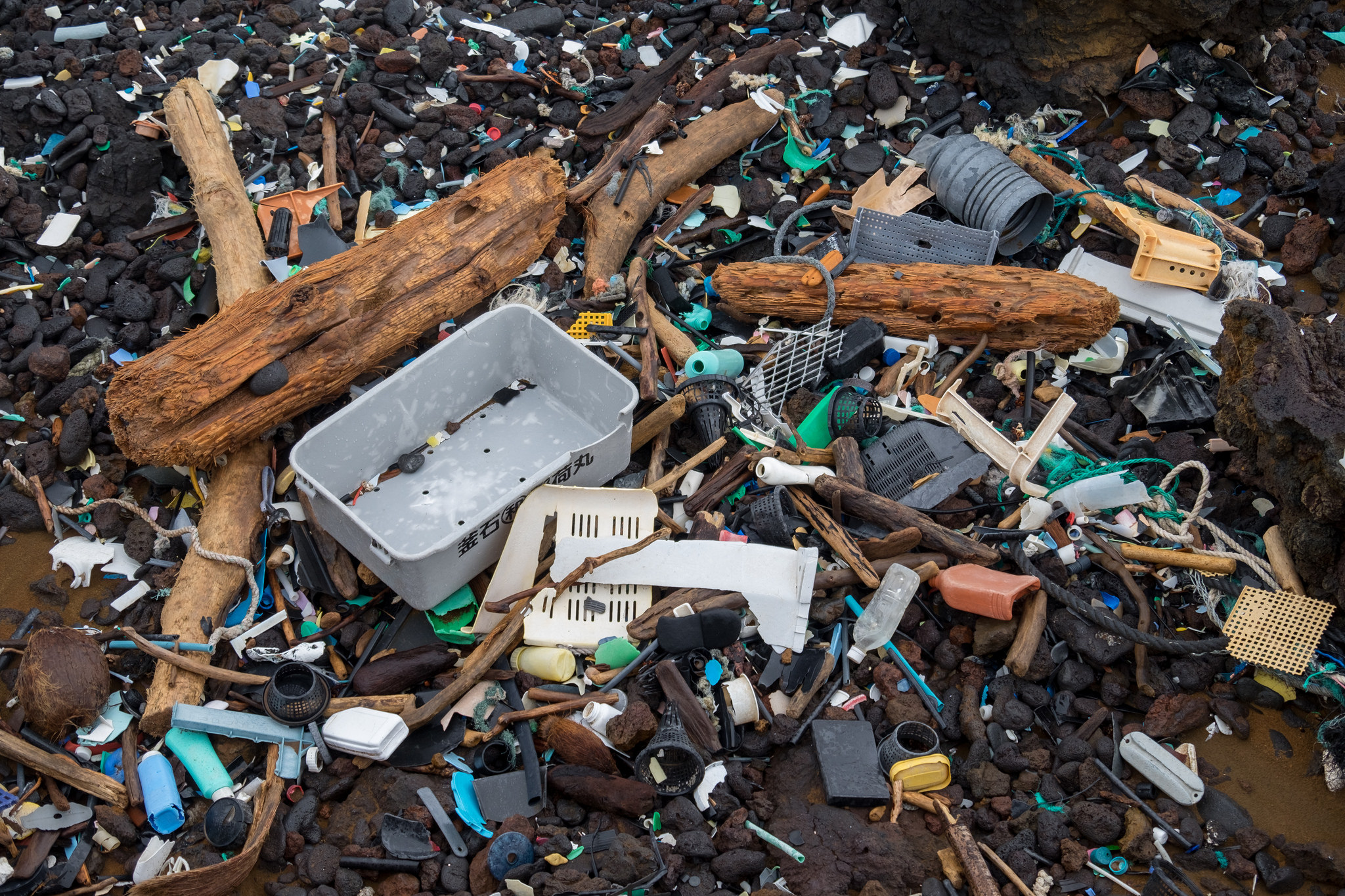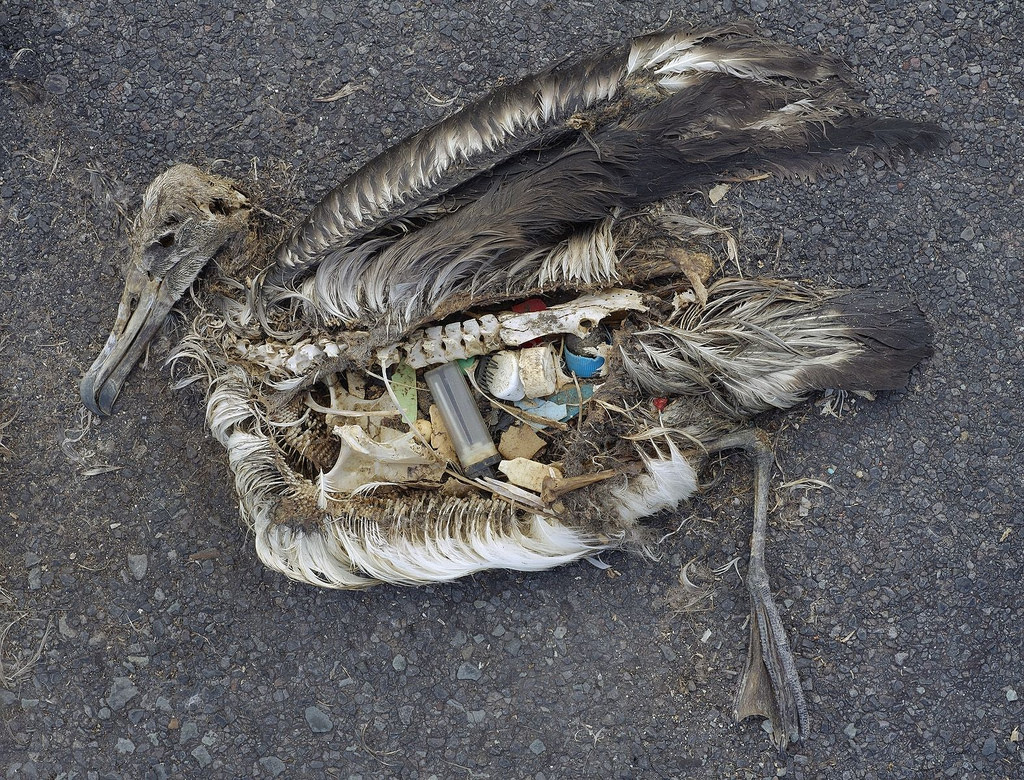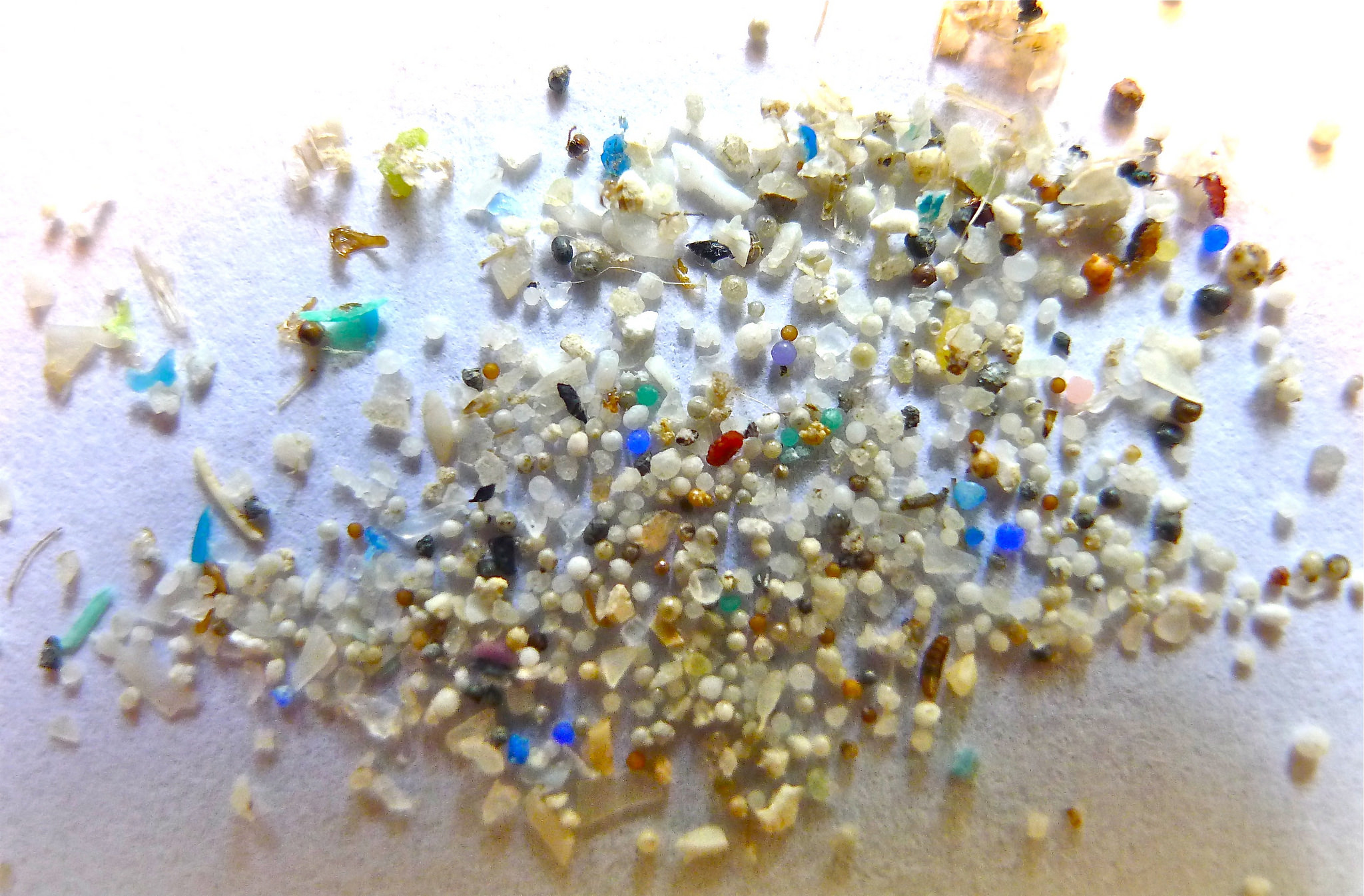Pollution
3.2 Ocean Plastic Disappearance Presents Untold Damage to Sea Life
Tiana L. Ahmed
One of the largest collections of human waste, the Great Pacific Garbage Patch, is affecting ocean life. Plastics in the waste are breaking down into small beads and are consumed by marine creatures. Will international action occur to reduce this waste and prevent further harm to these species?

Through years of overconsumption, humans now face the large problem of how to efficiently reuse and dispose of the seemingly endless amount of waste. When garbage is improperly disposed of, objects are often found stuck in trees, consumed by wildlife, or floating in bodies of water. One of the largest collections of human waste affecting ocean life is the Great Pacific Garbage Patch.7
First discovered by Charles Moore in 1997, the Great Pacific Garbage Patch is a gyre of marine debris that traps primarily human garbage.5,6,8,9 This patch was created by garbage sucked directly into the ocean or through smaller bodies of water. There are several gyres labeled garbage patches in Earth’s oceans, and while they are difficult to measure, the Great Pacific Garbage Patch remains the largest known patch with a size larger than the state of Texas.3 Most think of the garbage patch as a blanket of trash that can be easily collected, however the area is in constant motion and changes with the ocean currents.7 Scientists have estimated the mass of the patch at 3.5 million tons, and it is mostly composed of millions of pieces of microplastic trapped in a vortex of water.9 Ocean currents follow a very circuitous route, taking five years for a piece of trash to exit the gyre.9
The presence of the debris already poses a danger to marine life since the floating plastic primarily consists of polyethylene, polypropylene, and other toxic pollutants, ranging from polychlorinated biphenyls (PCBs) to mercury, that cling to the object’s surface.2 The problem with plastic is that it does not biodegrade, but rather breaks down into increasingly smaller pieces.9 Marine life confuses the microplastic with food and scientists have found that nearly 50% of fish being examined contain plastic in their stomachs.9 The larger pieces of garbage are also being consumed by wildlife. This is evident on the island of Midway Atoll, which is known as an albatross graveyard, for upon opening the stomachs of dead albatross’, scientists have consistently found large quantities of garbage in their system (Figure 2).1,6

Recently, a new study has found that 99% of the ocean’s plastic is missing.2 The National Academy of Sciences estimates that of the 300 million tons of plastic humans produce each year, only 0.1% washes into the oceans.2 To track this garbage, four ships of the Malaspina expedition, fished for plastic among the main five subtropical gyres believing that they would uncover millions of tons of debris.2,3 However, much less plastic was discovered.2 Based on their collection, the researchers calculated that the global sum of plastic in the oceans equated to 40,000 tons.2,6 This discovery failed to answer where the is plastic going. The plastic is somewhere, either ingested by ocean life, in the depths of the ocean, or broken down into fine particles undetectable by nets.2,8
Many studies conducted have begun to trace the disappearance of microplastic due to its consumption by fish. The most frequent plastic size ingested by fish in all studies examined was between 0.5 and 5 mm.3 This ingestion has detrimental effects to fish populations due to the contents of the plastic. The Malaspina expedition’s analysis confirmed the identity of all the plastic particles collected, and polyethylene was found to be the most common polymer type.3 This polymer composes 29% of plastic production globally.10 These plastic contents are known to affect the liver and induce hepatic stress in fish.10 Another concern with the consumption of toxic plastic debris is the affects it will have on the food chain. Pesticides and organic pollutants such as polychlorinated biphenyls (PCBs) are consistently found attached to plastic waste at harmful concentrations; 100 times those found in sediments, and 1 million times those occurring in sea water.11 These chemicals disrupt the main biological processes such as cell division and immunity, which may cause disease, reduce an organism’s ability to escape from predators, or affect reproduction.11 Other organisms connected to the ocean, such as seabirds, have consumed plastic waste and have PCBs in their tissues at 300% greater concentrations than in those that have not eaten plastic.11 The food chain is also harmed by the imbalance between predator and prey. Recent evidence suggests that the sea skater (Halobates sericeus) is utilizing floating debris as a new protective solid to lay eggs.4 With more opportunities to lay eggs, the sea skater population will increase, and may lead to the depletion of the plankton they feed on, disrupting the food chain.4

Another explanation for the disappearance of plastic in the oceans is that the microplastic debris is falling to the ocean floor.2,3,6 The plastic fragments ingested by small fish can be transferred to larger predators, sink with the bodies of dead fish, or be defecated.3 Deep-sea marine life may be enduring long term harms that humans have yet to discover, since much of the ecosystem is too deep to be thoroughly researched.
The issue of microplastic plaguing the oceans needs to be addressed at an international level. The International Convention for the Prevention of Pollution From Ships (MARPOL) was signed in 1973, although a complete ban on the disposal of plastics at sea was not enacted until the end of 1988.11 Despite 134 nations agreeing to eliminate plastic disposal at sea, governments have struggled for decades to reduce dispersion of plastic debris and oceanic sampling suggests that the problem has persisted or worsened since MARPOL was signed.11 Despite numerous studies, the long-term issue remains that scientists cannot trace where all of the plastic particles have moved and therefore cannot collect all the particles that filter into the ecosystem. The only way to prevent future harm to marine life is to reduce human consumption and enact better disposal methods. If it is not possible to reverse the damage that has been done, prevention needs to start at the source.
Figure 4. Garbage Patch Visualization Experiment. Courtesy of Greg Shirah and Horace Mitchel, NASA Scientific Visualization Studio. Public Domain.
References:
- Carr, V. (2010, August 9). An Ocean of Plastic. Need to Know on PBS. Retrieved from http://www.pbs.org/wnet/need-to-know/environment/an-ocean-of-plastic/2686/
- Chen, A. (2014, June 30). Ninety-nine percent of the ocean’s plastic is missing. Science, Retrieved from http://www.sciencemag.org/news/2014/06/ninety-nine-percent-oceans-plastic-missing
- Cózar, A., et al. (2014). Plastic debris in the open ocean. Proceeding of the National Academy of Sciences in the United States, 111(28):10239-10244
- Goldstein, M.C., et al. (2012). Increased oceanic microplastic debris enhances oviposition in an endemic pelagic insect. Biology Letters, 8:817-820
- Kaiser, J. (2010, June 18). The dirt on ocean garbage patches. Science, 328(5985):1506
- Lytle, C.L. (2015, September). Where the Mermaids Cry: The Great Plastic Tide. Costal Care. http://coastalcare.org/2009/11/plastic-pollution/
- Office of Response and Restoration (Producer). (2014). The Great Pacific Garbage Patch. Making Waves: Episode 126 [Audio podcast]. National Oceanic and Atmospheric Administration (NOAA). Retrieved January 28, 2016, from http://response.restoration.noaa.gov/multimedia/podcasts/great-pacific-garbage-patch-episode-126.html
- Parker, L. (2014, July 16). First of Its Kind Map Reveals Extent of Ocean Plastic. National Geographic. Retrieved from http://news.nationalgeographic.com/news/2014/07/140715-ocean-plastic-debris-trash-pacific-garbage-patch/
- PBS News Hour (Producer). (2008, November 14). World’s Ocean Face Problem of Plastic Pollution [Video podcast]. Retrieved January 28, 2016, from http://www.pbs.org/newshour/bb/environment-july-dec08-plasticocean_11-13/
- Rochman, C.M., et al. (2013a). Ingested plastic transfers hazardous chemicals to fish and induces hepatic stress. Nature, 3(3263):1-7
- Rochman, C.M., et al. (2013b). Policy: Classify plastic waste as hazardous. Nature, 494:169–171
Figures:
- 5Cyres, Oregon State University. (2012). [Photograph of microplastics]. Retrieved from FlickrCommons. CC BY-SA 2.0.
- Bombardier, Joel. (2005). [Photograph of recycling bins]. Retrieved from FlickrCommons. CC BY 2.0.
- Dolske, Justin. (2016). [Photograph of the great pacific garbage patch]. Retrieved from FlickrCommons. CC BY-SA 2.0.
- Jordan, Chris. (2009). [Photograph of albatross at midway atoll refuge]. Retrieved from FlickrCommons. CC BY 2.0.
- Shirah, Greg and Horace Mitchell, National Oceanic and Atmospheric Administration. (2015). [Video of garbage patch visualization experiment]. Retrieved from https://svs.gsfc.nasa.gov/4174. Public Domain.
